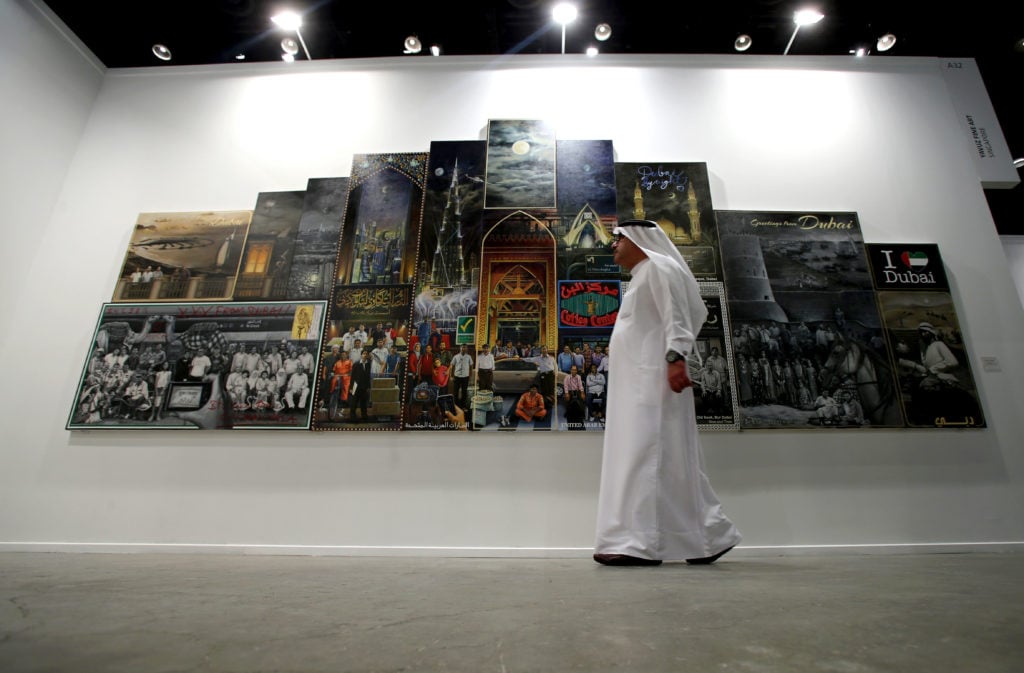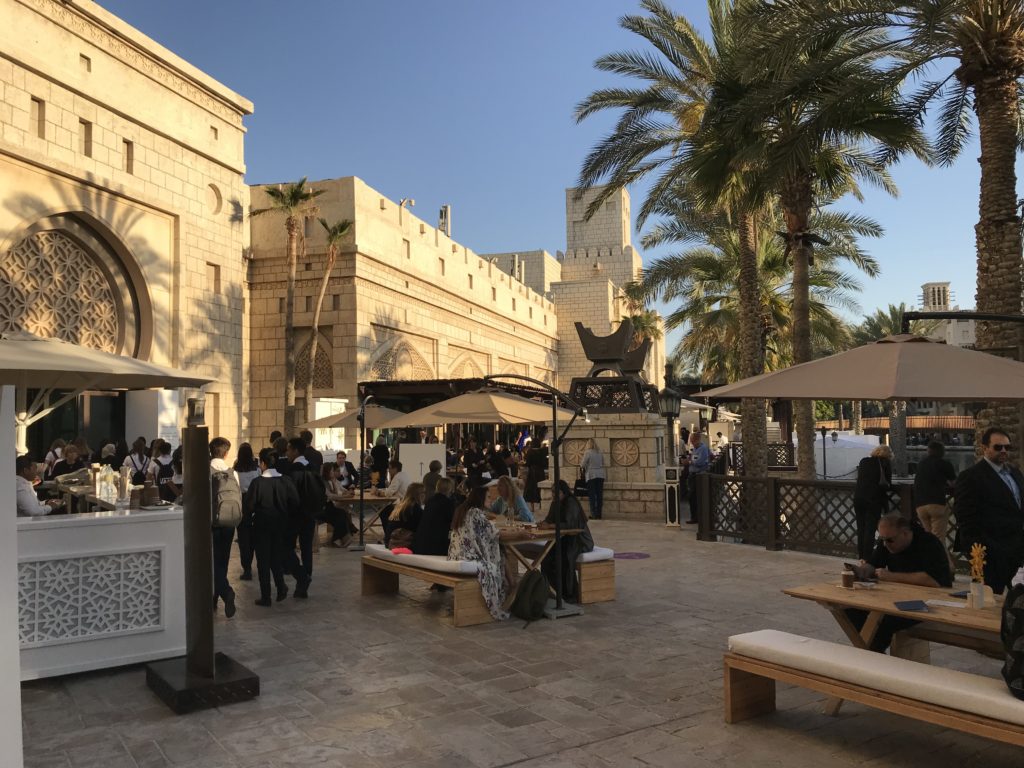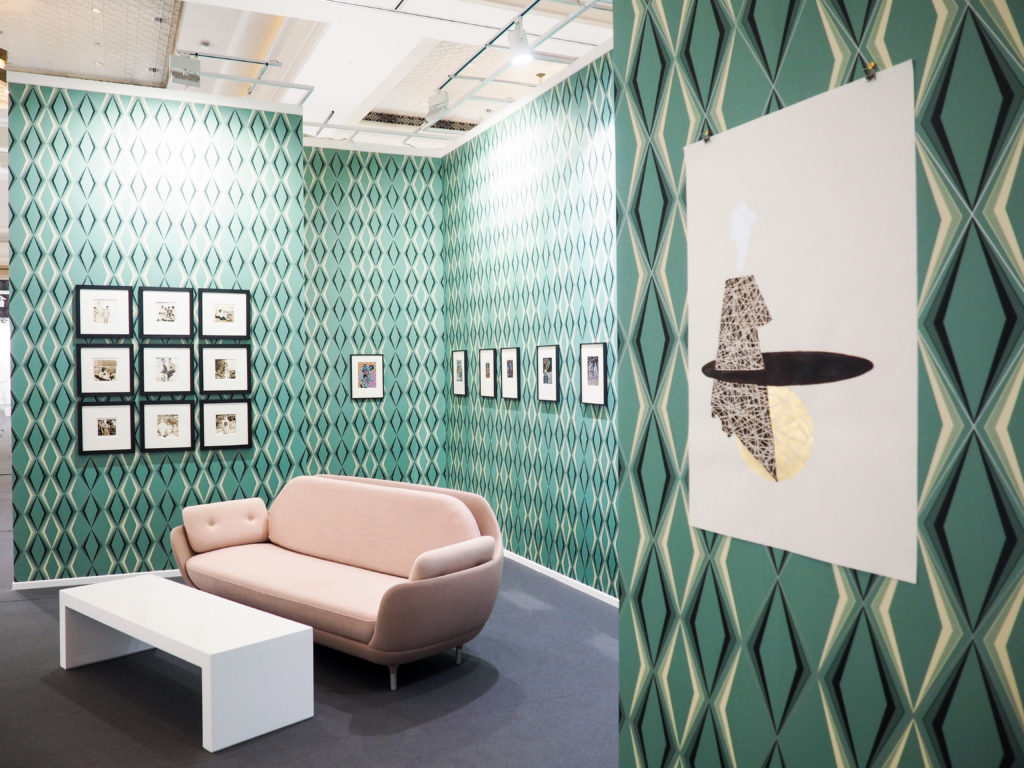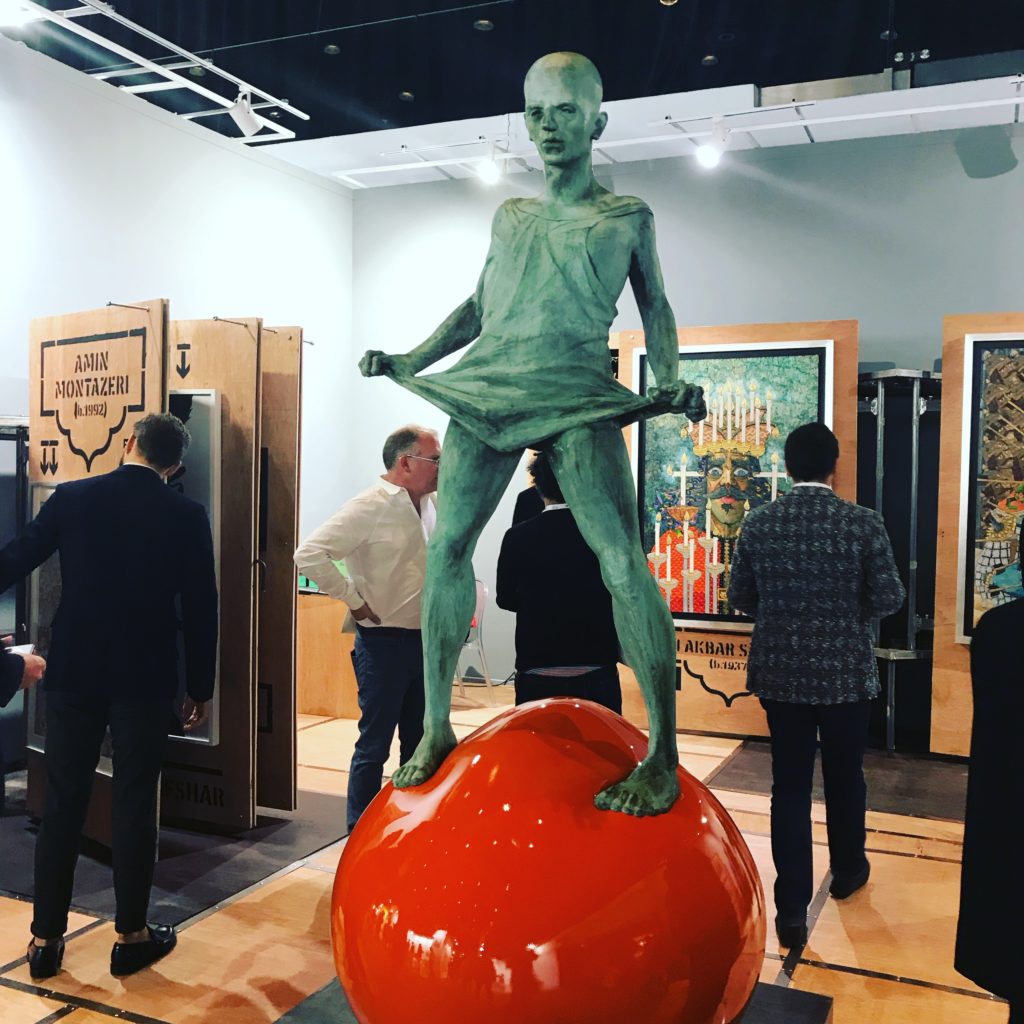Art World
Art Dubai Finds Its Footing Thanks to a Saudi Art Renaissance and the New Louvre Abu Dhabi
After a sluggish few years, the fair's 12th edition felt reinvigorated with strong sales and heavy foot traffic.

After a sluggish few years, the fair's 12th edition felt reinvigorated with strong sales and heavy foot traffic.

Arsalan Mohammad

![]()
A young woman in an embroidered burqa giggled and adjusted a virtual reality headset perched uneasily on her head. Her companion, an elegant man in a long dishdasha, smiled but politely refused to join her. She was watching Reframe Saudi, a lavish VR film that features contemporary Saudi Arabian artists guiding viewers around their workspaces and their home cities, all while basking in the sunshine of a new era of social reform, liberalization, and embrace of the outside world.
Both virtual reality and Saudi Arabia dominated the 12th edition of the Art Dubai fair this week, which runs through March 24. Two years ago, the idea that Saudi Arabian entities such as Art Jameel, the Misk Art Foundation, and Culturunners would be anchoring substantial portions of the 2018 program would itself seem like virtual reality. But the current burst of artistic energy emanating from Saudi Arabia under the aegis of the Crown Prince Mohammed bin Salman has galvanized an Arab art scene that has been in danger of subsiding into self-congratulatory torpor in recent years. The sluggishness of recent underwhelming editions of Art Dubai seems to now be changing for the better.
The fair itself was in good health this year. The event, the second edition under the directorship of Dubai-raised Myrna Ayad, featured 78 galleries from 42 countries. There were much-hyped initiatives, such as “Residents,” a new program dedicated to solo presentations from artist residents in Dubai who created (somewhat unremarkable) work that “merge[d] their distinct artistic practice with their surroundings.”

The scene at Art Dubai, 2018. Photo: Arsalan Mohammad.
The opening night and VIP preview saw halls packed with the usual blend of Arab, Iranian, and Indian collectors who were briskly slapping down checkbooks, rather than tentatively making reservations.
“The foot flow has been excellent so far, and sales rather satisfactory for the current situation, where everybody was expecting the worst,” said Beirut dealer Saleh Barakat of Agial Gallery. He sold three works by the Lebanese painter Tagreed Darghouth and other work by Lebanese artist Hiba Kalache; two of the buyers were new. “In general, there are a lot of new faces here,” he said.
Marianne Boesky Gallery sold Matthias Bitzer’s Consoler of the Confounded (2018) to a collector from the Middle East for $50,000 and a popular The Falcon and the Bandit (2017) by Syrian painter Diana Al-Hadid for $120,000. Dubai-based Meem Gallery’s solo booth of work by the Palestinian painter Kamal Boullata also attracted a great deal of interest, with three $30,000 abstract works exchanging hands on preview night to collectors from Germany, South Africa, and Dubai.

Installation view of Kristin Hjellegjerde Gallery at Art Dubai, 2018. Photo by Arsalan Mohammad.
London’s Kristin Hjellegjerde Gallery was effervescing with excitement as a substantial number of pieces sold from her moving solo presentation of works by Iranian-born, UK-based artist Soheila Sokhanvari, who delicately paints with egg tempera and smuggled Iranian crude oil. “We’ve sold half our booth,” she said, noting that the works went to the Los Angeles County Museum of Art and important private collections. “We’ve met a lot of great people, all kinds of nationalities.”
Although the overall mood was optimistic, one Dubai-based dealer bemoaned the absence of major international blue-chip galleries and a prominent Lebanese collector, Basel Dalloul, derided the general standard of the booths at the opening night. “The selections of the various galleries were kind of weak both for the contemporary and the Modern,” Dalloul told artnet News. “Some galleries in the contemporary [section] were showing the same tired art in the same booths! That was kind of disappointing.”
Dubai’s Isabelle van den Eynde rather crankily refused to answer “stupid” questions about sales, but praised the quality and diversity of visitors to the gallery’s booth. Meanwhile, Wendi Norris of the eponymous San Francisco gallery returned to Dubai after a three-year hiatus, bringing a dramatic, highly Instagrammable cartographic sculpture by Val Britton.
Norris said she was lured back by the network of collectors and friends she had in the region and the opportunity to see the newly opened Louvre Abu Dhabi. In Dubai, there are “international, high-level professionals asking all the right questions and everyday people who have enough income to afford art,” she said. “I’ve been on my feet eight hours talking to people.”

Installation view of Dastans Basement gallery at Art Dubai 2018. Photo by Arsalan Mohammad.
Across from the halls of contemporary art, the fair’s regular platform for Modern work was in full swing, though it was less enthusiastically received than in previous years. “The Modern section is slower for sure,” said Saleh Barakat. “There is interest that has not been converted into real sales so far.”
Over-fishing in the relatively small pool of 20th-century Arab and Iranian art in recent years has left slim pickings for buyers at the 2018 fair. Yet the boom among collectors for this “Modern” work is suffering from a lack of historical documentation, a problem exacerbated in recent years by the destruction of historical scholarly archives in museums and libraries across Syria, Iraq, and Afghanistan.
A much-needed corrective came in the form of renowned art historian Nada Shabout, who with New York’s Museum of Modern Art published Modern Art in the Arab World, a weighty tome on sale in the section. It comes at a time when pressing questions about provenance and authenticity in 20th-century Arab art are at an all time high, with rumors and counter-rumors and unsubstantiated allegations peppering many a late-night conversation at this year’s fair.
“The Modern [section] really was weak,” said Dalloul, whose vast family collection of Middle Eastern and North African art from the 20th century is soon to open to the public in a private Beirut museum.
The only “saving grace,” Dalloul said, was the Misk Institute’s group show, curated by Sam Bardaouil and Till Fellrath, titled “THAT FEVERISH LEAP INTO THE FIERCENESS OF LIFE.” It was a curious selection of 75 works from across the Arab world, dating between the 1940s and ’80s. The show offered a pleasing counterpoint to the tech frenzy apparent at the fair’s garish setting, the Madinat Jumeirah, where VR was represented by the superb winner of the $100,000 Abraaj Group Art Prize, Lawrence Abu Hamdan. His hard-hitting video piece, Walled Unwalled, was a timely polemic decrying the idea of walls and separations (it included, at one point, the screams of Oscar Pistorius’s murdered fiancée, Reeva Steenkamp).
Overall, the early takeaway from this year’s Art Dubai is that it is a fair comfortable in its niche as a regional leader. In years to come, uncertainty in the broader region may transform it in ways we cannot anticipate. And though it may not be a global contender yet, it is all the stronger for that stance.